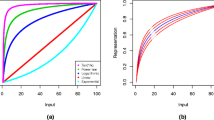Abstract
A central task of perception can be defined as one of computing hierarchies of invariants. One way of representing such invariants in intermediate levels of abstraction in this hierarchy is to use discrete units. These have been termed value units. A problem with such an encoding is that there has not been a good way to represent accurate numerical quantities using these units. This paper remedies the deficiency by describing a scheme that interpolates values between units representing fixed numerical quantities. The scheme has nice properties: it extends across functional mappings and it allows different sources of evidence to be combined.
Similar content being viewed by others
References
Ackley DH, Hinton GE, Sejnowski A (1985) A learning algorithm for Boltzmann machines. Cognitive Sci 9:147–169
Andersen RA, Essick GK, Siegel RM (1985) The encoding of spatial location by posterior parietal neurons. Science 230:456–458
Ballard DH (1984) Parameter nets. Artif Intell 22:235–267
Ballard DH (1986) Cortical connections and parallel processing: structure and function, TR 133, Computer Science Dept., U. Rochester, revised January 1985 Behav Brain Sci (to appear)
Ballard DH, Hayes PJ (1984) Parallel logical inference, Proceedings of the Sixth Annual Conference of the Cognitive Science Society, pp. 286–292. Boulder, CO, June
Ballard DH, Hinton GE, Sejnowski TJ (1983) Parallel visual computation. Nature 306:5938, 21–26
Barlow HB (1972) Single units and sensation: a neuron doctrine for perceptual psychology? Perception 1:371–394
Brown CM (1983) Inherent bias and noise in the Hough transform. IEEE Trans PAMI 5:493–505
Davis PJ (1963) Interpolation and approximation. Blaisdell, New York
Duda RO, Hart PE (1972) Use of the hough transform to detect lines and curves in pictures. Commun ACM 15:11–15
Feldman JA (1985) Four frames suffice: a provisional model of vision and space. Behav Brain Sci 8:265–289
Feldman JA, Ballard DH (1982) Connectionist models and their properties. Cogn Sci 6:205–254
Freuder EC (1978) Synthesizing constraint expressions. CACM 21:958–965
Geman S, Geman D (1984) Stochastic relaxation, Gibbs distributions, and the Bayesian restoration of images. IEEE Trans PAMI 6:721–741
Hinton GE (1981) Shape representation in parallel systems. Proceedings of the 7th International Joint Conference on Artificial Intelligence, pp 1088–1096. Vancouver, BC, Canada
Hinton GE (1984) Distributed representations. Technical Report, Computer Science Dept., Carnegie-Mellon University
Hinton GE, Sejnowski TJ (1983) Optimal perceptual inference. Proceedings of the IEEE Computer Vision and Pattern Recognition Conference, pp 448–453. Washington, DC
Hinton GE, Sejnowski TJ, Ackley DH (1984) Boltzmann machines: constraint satisfaction networks that learn, TR CMU-CS-84-119, Computer Science Dept., Carnegie-Mellon University
Hopfield JJ (1982) Neural networks and physical systems with emergent collective computational abilities. Proc Natl Acad Sci USA 79:2554–2558
Hopfield JJ (1984) Neurons with graded response have collective computational properties like those of two-state neurons. Proc Natl Acad Sci USA 81:3088–3092
Hopfield JJ, Tank DW (1985) Neural' computation of decisions in optimization problems. Biol Cybern 52:141–152
Hummel R, Zucker S (1983) On the foundations of relaxation labeling processes. TR 80-7, McGill U., Montreal, IEEE Trans PAMI 5:267–287
Jaeger JC, Starfield AM (1974) An introduction to applied mathematics. Oxford University Press, Oxford
Kirkpatrick S, Gelatt CD Jr, Vecchi MP (1983) Optimization by simulated annealing. Science 220:4598, 671–680
Levinson E, Sekuler R (1976) Adaptation alters preceived direction of motion. Vision Res 16:779–781
Li H, Levin MA, LeMaster RJ (1985) Fast Hough transform. Proceeding of the 3rd Vision Workshop, Bellaire, MI
Prager JM (1980) Extracting and labeling boundary segments in natural scenes. IEEE Trans PAMI 2:16–27
Rosenfeld A, Kak A (1976) Digital image processing. Academic Press, New York
Rosenfeld A, Hummel RA, Zucker SW (1976) Scene labelling by relaxation operations. IEEE Trans SMC 6:420–433
Rumelhart DE, Zipser D (1985) Feature discovery by competitive learning. Cogn Sci 9:75–112
Rumelhart DE, Hinton GE, Williams RJ (1985) Learning internal representations by error propagation, ICS Report 8506, Institute for Cognitive Science, U. California, San Diego, September
Sakata H, Shibutani H, Kawano K (1983) Functional properties of visual tracking neurons in posterior parietal association cortex of the monkey. J Neurophysiol 49:1364–1380
Saund E (1986) Learning continuous values in networks. Proceedings of the AAAI-86, Philadelphia, PA
Smolensky P (1986) Foundations of harmony theory: cognitive dynamical systems and the subsymbolic theory of information processing. In: Rumelhart DE, McClelland JL (eds) Parallel distributed processing: explorations in the microstructure of cognition, vol 1: Foundations. Bradford Books/MIT Press, Cambridge, MA
Sullins J (1985) Value cell encoding strategies. TR 165, Computer Science Dept., University Rochester
Ullman S (1979) Interpretation of visual motion. MIT Press, Cambridge, MA
Van Essen DC (1986) Functional organization of primate visual cortex. In: Peters A, Jones EG (eds) Cerebral cortex, vol 3. Plenum Press, New York
Author information
Authors and Affiliations
Additional information
This work was supported in part by the National Science Foundation under Grant DCR-8405720 and the National Institutes of Health under Public Health Service Grant 1R01NS22407-01
Rights and permissions
About this article
Cite this article
Ballard, D.H. Interpolation coding: A representation for numbers in neural models. Biol. Cybern. 57, 389–402 (1987). https://doi.org/10.1007/BF00354984
Received:
Accepted:
Issue Date:
DOI: https://doi.org/10.1007/BF00354984




